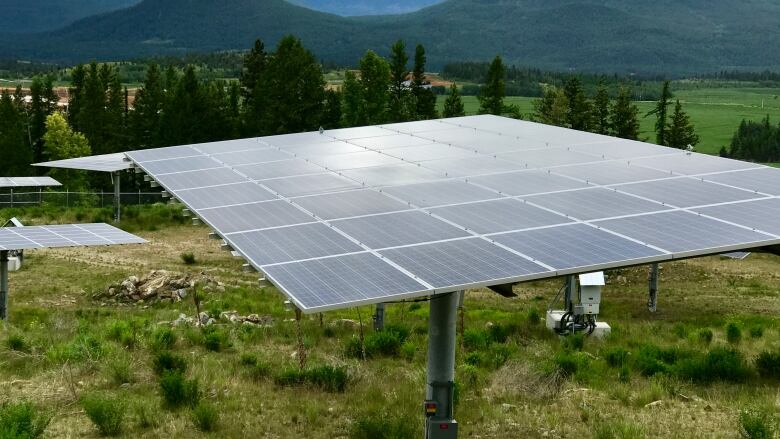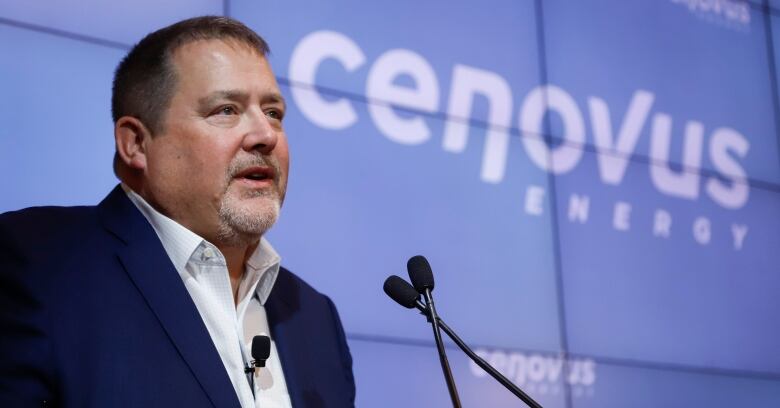Big oil companies have 'diametrically opposed' views on renewables
Why some oilpatch companies stick to oil, while others branch out into alternative energy

This week, Enbridge announced its new $20-million solar field in southern Alberta is up and running with 36,000 panels installed and generating up to 10.5 megawatts of electricity. That's enough to power about 3,000 homes, the company said.
Some of the electricity is for the company's oil pipeline system, which stretches across much of the country.
Make no mistake, Enbridge's bread and butter is the oil and natural gas business, but the company is increasingly expanding its focus on renewables and low-emitting sources of energy.
In today's oilpatch, a divide is growing between the oil majors as some companies are investing in alternative energy while other firmshave no interest in it. Both face their own risks and challenges as the world shifts to lower emitting sources of energy.
"They are almost diametrically opposed strategies," said Warren Mabee, director of theInstitute for Energy and Environmental Policy at Queen's University, in an interview.
There are those who see themselves as oil companies through and through. They have made massive investments to build up large reserves of oil and want to see those investments pay off for many years to come.
Then there are the companies who see themselves as energy firms who will adapt their operations to what the market demands.

Committed to crude
This week, Cenovus, Canadian Natural Resources and Imperial Oil all reiterated their stance they have no appetite to build their own wind or solar. Instead, the focus is squarely on being oil and gas companies.
That's not to say they aren't taking steps to reduce their impact on the environment.
Canadian Natural has cut the emissions intensity of its operations by 18 per cent from 2016 to 2020, Cenovus by 30 per cent in the past decade and Imperial by 20 per cent between 2013 and 2017 at its oilsands operations, the companies said.
Executives with those companies say they there is an opportunity to make more environmental progress by focusing on innovation and new technology in their oil and gas operations, while also meeting society's ongoing demand for those products.
The oilsands makes up about 11 per cent of the country's total emissions, according to 2018 data from the federal government, and other oil and natural gas production makes up another 11 per cent.
"The preference is to stick with what we know and what we're good at," said Tim McKay, president of Canadian Natural, during the Scotiabank CAPP Energy Symposium.
"If I was to get into wind power, I would have to relearn it and figure out how I could compete with other producers," he said.
In the past, some executives have said it's not about a lack of knowledge, since oil majors have branched out into new ventures like petrochemicals without any prior experience.
Cenovus chief executive Alex Pourbaix said the only renewable energy consideration would be potentially purchasing the electricity from a third party.
"Where we're likely to remain is focused on oil and gas production," he saidat the symposium.
"Don't look for us to become a late-entrant renewable-power developer."

Pivoting to alternatives
For other oil majors, branching out beyond oil and gas isn't new and they are continuing to expand their focus as the energy transition occurs and the world moves to lower-emitting sources of energy.
Suncor has been a player in the wind farm industry for a few decades and is also investing in alternative energy projects like producing sustainable aviation fuel. It's committing about 10 per cent of its capital spending on these types of projects.
The company doesn't hide the fact it has the money to make these investments because of the cash it generates from oil production. Suncor is also firmly entrenched in the oil industry. For instance, the company is working to expand its oilsands mines so they will have a lifespan into the 2040s and beyond.
TC Energy is developing utility-scale electricity storage projects and hydrogen technology, while also investing in solar and nuclear power. Still, it sees great value in its oil and natural gas operations.
"[The] transition can't come fast enough for us, from my perspective, but we have to pace it appropriately. And I believe that natural gas and liquids will continue to play a prominent role in the energy economy for decades to come," said chief executive Franois Poirier.

'A risky game'
While the strategies of some oil majors seem to directly oppose each other, both face challenges and are "playing a risky game," said Mabee with Queen's University.
"If you can diversify, you can invest in different things so the chances of a catastrophic loss maybe go down," he said.
Whereas the companies that just stick to oil, they risk being left with stranded assets.
"If things don't work out you don't have very many options," he said.
Branching too far away from oil and gas could bring financial challenges. Companies can struggle to generate the same level of profits from a wind farm, for instance, as from oil production.
Canadian Natural expects to generate between $2 billion and$2.5 billion of profit in 2021, based on benchmark oil prices of $45 US per barrel. This week, prices are around $60 US.
On the other hand, companies who remain strictly devout to fossil fuels may be putting all their eggsin one basket and face risks with climate policy, which could drive up costs.
There could be government policy targeting the oilpatch in years to come, similar to the phase out of coal in recent years.
"You've got policymakers around the world that are rethinking the central role that oil plays in modern life, starting with the Biden administration," said Ed Whittingham, a clean energy consultant and former executive director of the Pembina Institute, an environmental policythink-tank, in an interview.
Whittingham said companies are developing new strategies as many experts predict oil demand will decline in the future. That's why some companies are focused on driving down costs and carbon emissions from their oil business, while others are looking to produce more renewable and low-emission electricity.
For Enbridge, its new solar farm is part of a larger vision to reduce greenhouse gas emissions by relying on renewable energy to power compression stations, displacing the amount of electricity produced by coal and natural gas power plants, for instance.
And there's no need for a lawn mower on site, since the company is bringing in 50 grazing sheep to keep the grass down between the rows of solar panels.












_(720p).jpg)


 OFFICIAL HD MUSIC VIDEO.jpg)
.jpg)



























































































